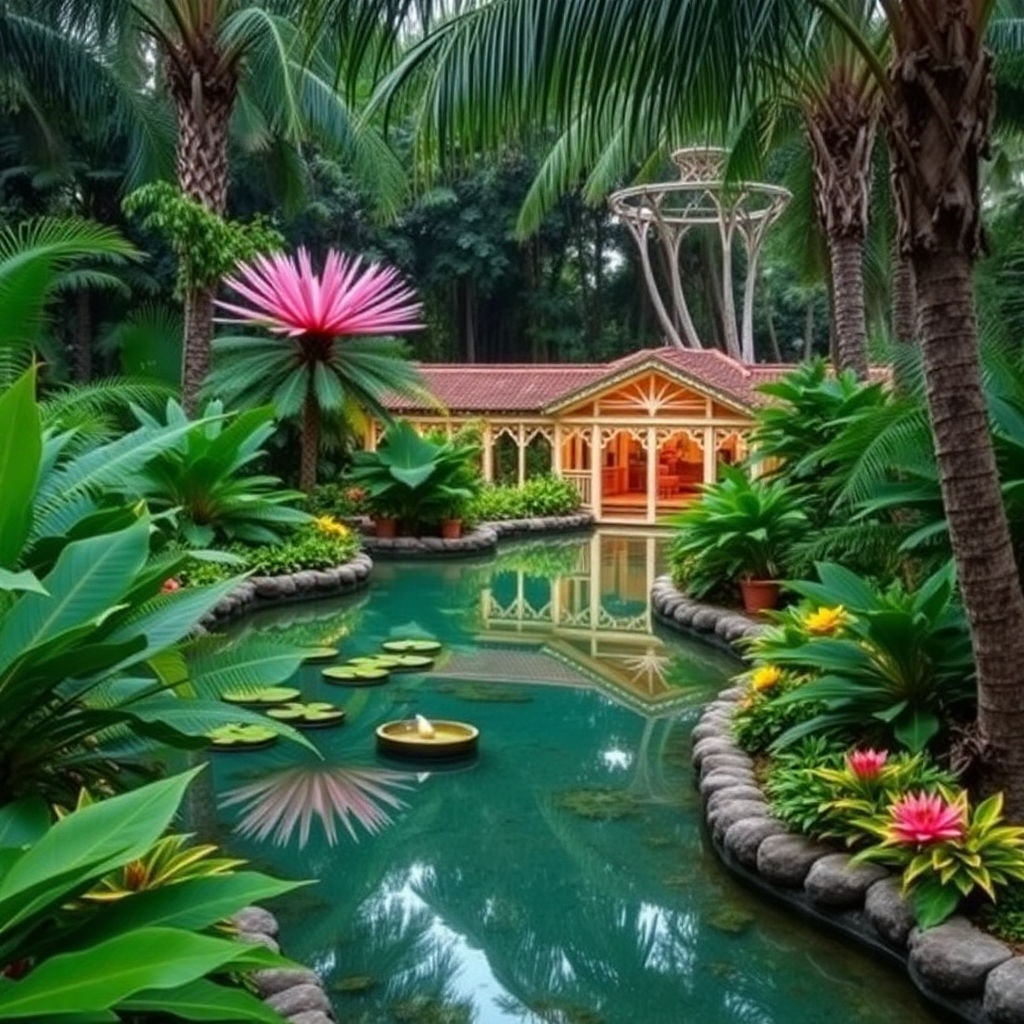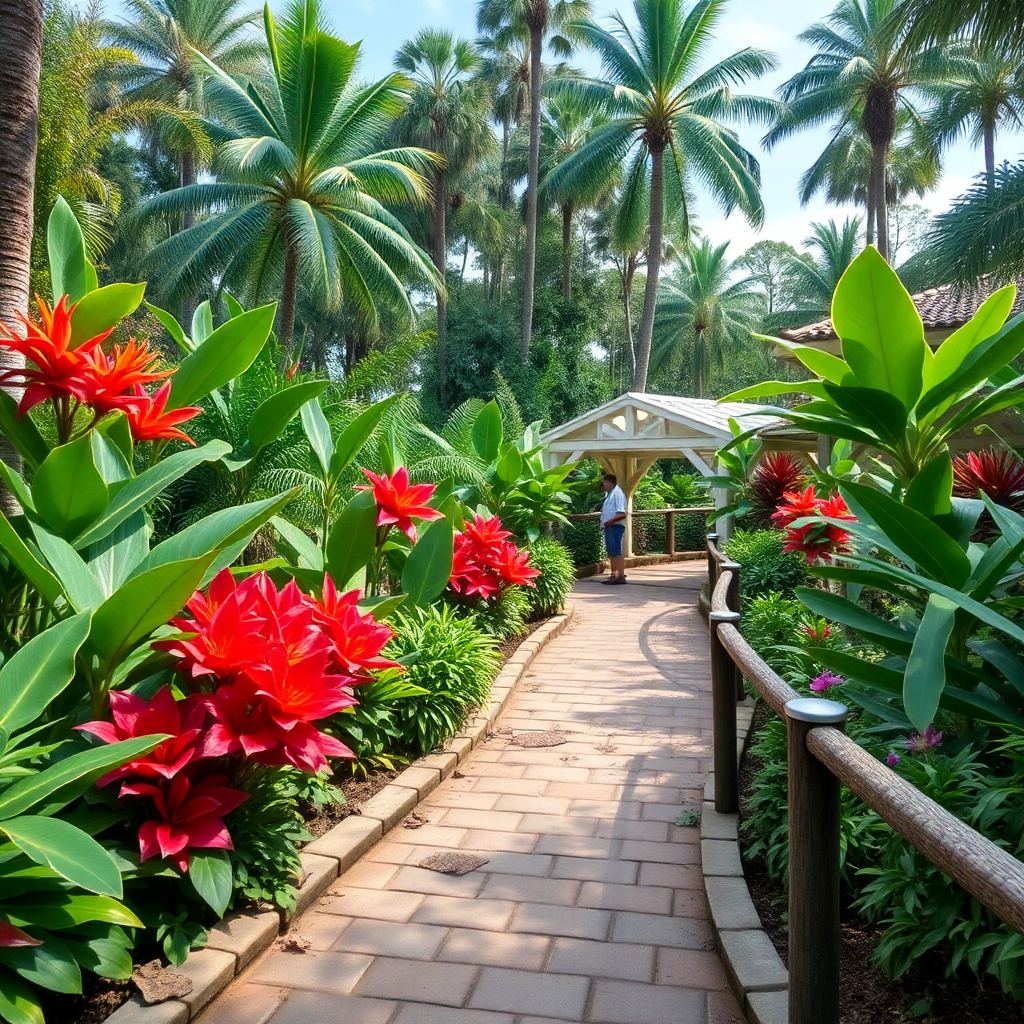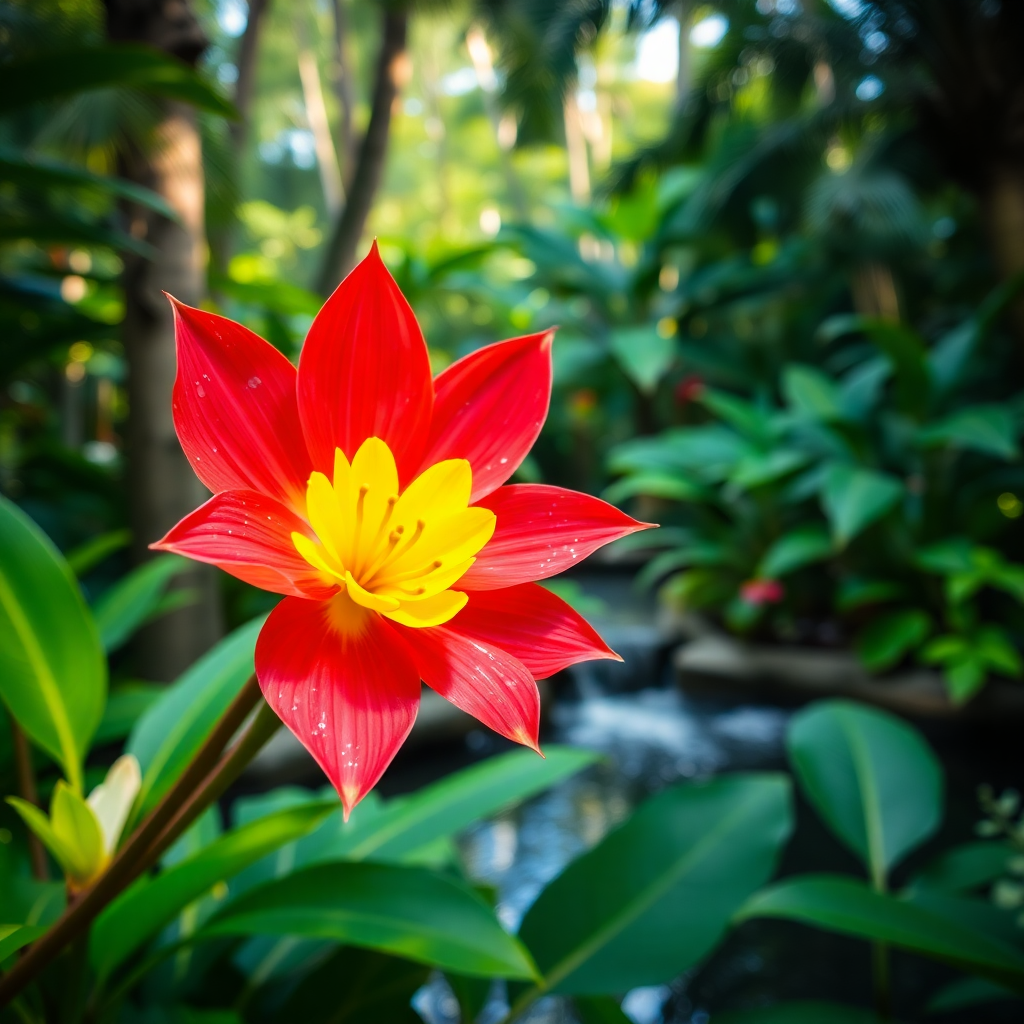Fairchild Tropical Botanic Garden:
Inspiring Garden Design Ideas in Florida

Did you know that visiting a botanical garden can increase your creativity by up to 60% and reduce stress levels by nearly 40%? Fairchild Tropical Botanic Garden in Florida stands as one of the most remarkable sources of garden design ideas in North America. This 83-acre paradise showcases thousands of tropical plants and exemplifies how thoughtful landscape designs can transform ordinary spaces into extraordinary environments. Whether you’re looking to revamp your home garden or simply seeking inspiration from masterful gardening landscaping techniques, Fairchild offers countless ideas to enhance your own green space.
Information About Fairchild Tropical Botanic Garden
Fairchild Tropical Botanic Garden represents the pinnacle of tropical garden design in the United States. Located in Coral Gables, Florida, this botanical wonderland features:
- 83 acres of meticulously designed gardens, lakes, and natural ecosystems
- Over 3,400 species of rare tropical plants from around the world
- 11 distinct garden collections, each with unique landscape designs
- Award-winning garden architecture by landscape design pioneers
- Living laboratory for plant conservation and research
- Year-round educational programs for gardening enthusiasts
- Rotating art installations that complement the natural surroundings
- Photography-friendly environments with countless scenic viewpoints
The garden serves as an unparalleled resource for anyone interested in tropical landscaping designs, sustainable gardening practices, or simply connecting with nature in a thoughtfully curated environment.
Timing
A visit to Fairchild Tropical Botanic Garden typically requires 3-4 hours to fully explore and appreciate its diverse collections. According to visitor data, most garden enthusiasts spend an average of 3.5 hours exploring the grounds—significantly longer than the national average of 2.1 hours for botanical garden visits. For those with specific garden design interests, consider visiting during weekday mornings when crowds are lighter, allowing for uninterrupted contemplation of the landscape architecture. The garden is open year-round, with peak blooming seasons in spring (March-May) and fall (October-November) offering the most vibrant displays of tropical flora.
Step-by-Step Garden Exploration
Step 1: Begin at the Visitor Center
Start your garden design inspiration journey at the modern Visitor Center. Pick up a detailed map highlighting specialized garden areas and current seasonal highlights. The center itself showcases sustainable architecture with green walls and living roofs—excellent examples of integrating structures with landscape designs. Pro tip: Ask staff about the “Designer’s Choice” walking route, which highlights the most innovative landscape features currently in bloom.
Step 2: Explore the Wings of the Tropics Conservatory
Immerse yourself in the butterfly conservatory where landscape designs create microhabitats for thousands of exotic butterflies. Note how the plantings are strategically arranged to provide both nectar sources and larval host plants—a clever approach you can adapt for your home butterfly garden. The vertical gardening techniques demonstrated here work beautifully in limited spaces, showing how small areas can support diverse ecosystems.
Step 3: Wander Through the Richard H. Simons Rainforest
Experience the layered garden design approach in the rainforest exhibit, where plants are arranged in vertical zones mimicking natural forest structures. Pay attention to how shade-loving plants thrive beneath taller specimens—an excellent technique for home gardens with mature trees. The creative use of understory plants demonstrates how every inch of garden space can be maximized through thoughtful planning.
Step 4: Relax in the Lisa D. Anness South Florida Heritage Garden
Study how native plants are arranged in natural-looking groupings that require minimal maintenance yet provide maximum visual impact. This garden brilliantly demonstrates drought-resistant landscaping designs that maintain beauty while conserving resources. Take notes on the plant combinations that catch your eye—these groupings can be directly applied to Florida home gardens.
Step 5: Draw Inspiration from the Tropical Plant Conservatory
Marvel at the climate-controlled conservatory housing rare tropical specimens. While your home might not accommodate these exact plants, the design principles—using dramatic specimen plants as focal points surrounded by complementary smaller varieties—translate perfectly to residential garden designs. The clever use of containers and raised planters here offers solutions for challenging garden sites.
Step 6: Visit the Palmetum and Tropical Fruit Pavilion
Explore one of the world’s most comprehensive palm collections and learn how these architectural plants can define garden spaces. The adjacent fruit pavilion demonstrates how edible landscaping can be both beautiful and functional. Notice how fruiting plants are integrated into ornamental garden settings—a growing trend in modern landscape designs that combines aesthetics with sustainability.
Technical and Artistic Information
Fairchild Tropical Botanic Garden was founded in 1938 by Dr. David Fairchild, a famed plant explorer who introduced over 20,000 plant species to the United States. Located at 10901 Old Cutler Road in Coral Gables, Florida, the garden encompasses 83 acres of tropical paradise in USDA Hardiness Zone 10b, experiencing year-round temperatures ranging from 60-90°F with annual rainfall averaging 60 inches.
The garden’s mission centers on conserving tropical plants, advancing horticultural science, and educating the public about tropical botany and garden design. Its conservation efforts extend to protecting endangered plant species, with particular emphasis on preserving South Florida’s native flora.
Notable garden collections include:
- The Richard H. Simons Rainforest: Recreates the layered ecosystem of tropical rainforests with over 300 species
- The Wings of the Tropics Butterfly Conservatory: Features 40+ butterfly species amidst flowering tropical plants
- The Lisa D. Anness South Florida Heritage Garden: Showcases native plants arranged in natural-looking communities
- Montgomery Palmetum: Houses one of the world’s most comprehensive palm collections with over 500 species
- The Tropical Plant Conservatory: Protects rare plants requiring precise climate control
- The Lin Lougheed Spiny Forest of Madagascar: Recreates one of the world’s most endangered ecosystems
- Water Gardens: Demonstrate aquatic landscaping techniques featuring lilies and lotus
- Simons Rainforest Plaza: An open-air event space surrounded by tropical plantings
The garden’s architectural elements include the modernist Visitor Center designed by Cooper Robertson, multiple classic pavilions offering shade throughout the grounds, and the iconic Bailey Palm Glade with its dramatic vista of royal palms. Water features include a series of lakes and streams that serve both aesthetic and ecological functions within the landscape design.

Visitor amenities include:
- The Glasshouse Café serving seasonal, locally-sourced cuisine
- The Fairchild Farm satellite location for tropical fruit research
- Multiple gift shops featuring garden-inspired merchandise
- Educational classrooms and a scientific library
- The Whitman Tropical Fruit Pavilion
- Extensive walking trails with accessible routes
- Numerous shaded rest areas and observation points
- Event spaces for weddings and corporate gatherings
Annual events include:
- International Mango Festival (July)
- Chocolate Festival (January)
- Orchid Festival (March)
- Bird Festival (April)
- Gala in the Garden (February)
- Art exhibitions throughout the year
- Ramble Garden Festival (November)
- Holiday NightGarden illuminated experience (December)
Admission costs $24.95 for adults, with discounts for seniors, students, and children. Members enjoy free admission. The garden is open daily from 10am to 5pm, with extended evening hours during special events.
The garden is governed by a board of trustees and managed by professional horticulturists, botanists, and educators. Its maintenance team includes specialized staff for each garden collection, ensuring expert care of rare specimens. Conservation scientists conduct ongoing research into tropical plant preservation and sustainable gardening techniques.
Fairchild welcomes approximately 200,000 visitors annually, with 70% being local residents and 30% tourists from across the United States and 80+ countries. The garden contributes an estimated $12 million annually to the local economy and serves as a community hub for environmental education.
Healthier Alternatives to Traditional Garden Visits
For those seeking variations on the traditional garden experience, consider:
- Participating in Fairchild’s citizen science programs where visitors help collect data on plant growth and climate change impacts
- Joining a specialized guided tour focusing on edible landscaping principles
- Attending a garden design workshop, offered monthly, to learn hands-on techniques
- Exploring the garden at different times of day—early morning visits reveal different plant behaviors than afternoon tours
- Participating in the “Garden in a Day” volunteer experience where you’ll help install sustainable landscape features
- Downloading the Fairchild mobile app for self-guided thematic tours focusing on specific design principles
For families with diverse needs, the garden offers:
- Explorer backpacks with activities for children of different ages
- Sensory garden areas designed specifically for visitors with visual impairments
- Multiple rest areas with shade and seating throughout the grounds
- Accessible paths suitable for strollers and wheelchairs
- Early opening hours on select days for visitors who prefer quieter environments
Innovative Suggestions
Enhance your Fairchild garden experience by:
- Bringing a sketchbook to record inspiring plant combinations and garden layouts
- Taking close-up photographs of interesting plant textures and colors to reference for your own garden palette
- Creating a digital collection of favorite garden vignettes organized by design style
- Recording plant identification tags of specimens you might want to include in your own landscape
- Attending a seasonal plant sale to purchase specimens you’ve admired in the garden
- Participating in a photography workshop to better capture garden design ideas
- Joining the Fairchild Plant Society to connect with fellow garden enthusiasts
- Following up your visit with an appointment with one of Fairchild’s garden design consultants
Common Mistakes to Avoid
When visiting Fairchild for garden design inspiration, avoid these common pitfalls:
- Rushing through collections—garden design ideas often emerge from quiet contemplation of spaces
- Visiting during peak afternoon heat—morning visits are more comfortable and show plants at their best
- Focusing only on flowers—structural elements, textures, and foliage arrangements are equally important in garden design
- Neglecting to observe pathway materials and layouts—these “hardscape” elements are crucial to successful garden design
- Missing seasonal highlights—check the garden’s website before visiting to learn what’s currently featured
- Overlooking educational signage—these provide valuable insights into why certain plants are grouped together
- Attempting to see everything in one visit—consider a membership for multiple focused explorations
- Forgetting to document inspiration—take notes or photos of designs you’d like to adapt for your own space
Visitor Encouragement Tips
To make the most of your garden design inspiration visit:
- Wear comfortable walking shoes and sun protection—exploring garden design requires time on your feet
- Bring a refillable water bottle—hydration stations are available throughout the grounds
- Consider a guided tour with a landscape architect for professional insights into the design principles at work
- Visit during different seasons to understand how garden designs evolve throughout the year
- Attend a hands-on planting workshop to learn techniques for installing your own garden features
- Purchase the Fairchild plant guide to help identify specimens you might want to incorporate in your landscape
- Take advantage of the “Ask a Horticulturist” sessions held weekly at the garden
- Schedule your visit during specialized symposiums focusing on sustainable landscape design
Conclusion
Fairchild Tropical Botanic Garden offers an unparalleled opportunity to explore innovative garden design ideas in a stunning tropical setting. From its diverse collections showcasing plants from around the world to its thoughtfully designed landscapes, Fairchild provides endless inspiration for gardeners of all levels. Experience the magic of this botanical treasure and transform your own garden with ideas gleaned from one of Florida’s horticultural gems.
We invite you to share your Fairchild experiences in the comments section below. What garden design ideas inspired you most? Subscribe to our blog for more tips on bringing botanical garden magic into your own landscape.

Frequently Asked Questions
What makes Fairchild Tropical Botanic Garden different from other botanical gardens?
Fairchild specializes in tropical plants, with one of the world’s largest collections in a climate that allows year-round outdoor growing. Its landscape designs demonstrate how exotic species can be integrated into cohesive garden settings rather than merely displayed as specimens.
Can I apply the garden design ideas from Fairchild to my non-tropical garden?
Absolutely! While specific plants may differ, the design principles—creating visual layers, establishing focal points, using texture and color effectively, and incorporating water features—translate to any climate zone. Focus on the structural elements and plant relationships rather than specific species.
How often should I visit Fairchild for ongoing garden design inspiration?
Seasonal visits (4 times per year) provide the most comprehensive understanding of how garden designs evolve throughout the year. Each season highlights different plant collections and demonstrates how a well-designed garden maintains interest across changing conditions.
Does Fairchild offer any resources for home gardeners looking to implement similar designs?
Yes! The garden offers design workshops, maintains an extensive horticultural library, sells many featured plants at its nursery, and provides consulting services for home gardeners. Their website also features design guides and plant recommendations for South Florida landscaping.
What’s the best time of day to study garden design elements at Fairchild?
Early morning visits (10am-12pm) provide the best lighting for observing plant combinations and garden structure. The soft morning light reveals subtle color variations and textures that might be washed out in harsh midday sun.
